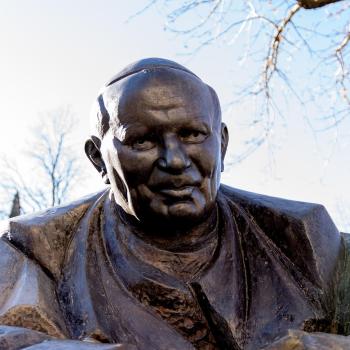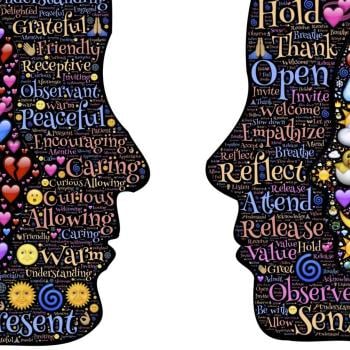On one occasion when I was present at a conference of progressive Christian academics, the well-known professor of New Testament studies, Marcus Borg (an out-of-the-closet mystic), was pressed by a skeptical peer (an atheist) to define what he meant when he used the word "God." After a little hedging, Borg responded with an invented word: "Is-ness."
This answer only infuriated his inquisitor, who demanded that Borg define "Is-ness." I think the audience knew that Professor Borg was not going to be able to get through to an atheistic academic who was firmly rooted in the reasoning mind.
As for "Is-ness," Buddhists often use a similar word: "Suchness" (Thathagatta) to name the Absolute. Two thousand years ago, the Buddhist sage Ashvaghosha wrote: "Suchness is neither that which is existence nor that which is nonexistence, nor that which is at once existence and nonexistence, nor that which is not at once existence and nonexistence."
Judaism also refused to name God, and simply referred to "Him" as YHWH, which means "I Am That I Am." God is Being itself, and the Kabalistic Ain Soph, in fact, means "nameless being."
Hindus have many names for the source of all Being, but each of them simply refers to different attributes of the Un-nameable One, or Brahman. Brahman, the Godhead, is composed of Brahma the Creator, Vishnu the Sustainer, and Shiva the Destroyer.
Manifest reality—the Universe—comes into being out of nothing, exists for a certain length of time (trillions of years) and is then destroyed—returning into a state of nothingness, or pure energy and potential—out of which another universe will eventually appear. According to Hinduism, this hide and seek game of God (lila) has been going on for eternity and will continue for eternity.
Apparent Dualism/Qualified Non-Dualism
The relationship between the spiritual lover and Beloved is classical mystical language, but our reality is dualistic. I like to call this our "default reality." The way we normally perceive things is how the Universe reveals itself to us when we are in our "default" consciousness. From a practical point of view, we could not communicate, teach, learn, make love, write books, perform medical procedures, build houses, or even question our own existence if we did not live with the perception of separateness. Our perceived dualistic reality allows us to function as human beings.
Behind appearances, Buddhists and Hindus would argue, everything is ultimately empty of substance. Current quantum theory in physics seems to suggest the same thing. If we put aside for the moment the philosophical intricacies in Buddhist and Hindu thought on the subject, we see that both philosophies claim that while phenomena are real enough, ultimately phenomena are empty of substance. The phenomenal realm is essentially an illusion, or maya.
Ancient Gnostic-Christians came to this same realization. They, however, decided that the world of matter, including the human body, was not just apparent reality, but was essentially evil in nature. According to them, matter was created by an evil demi-god. Gnostics considered the Creator God of the Bible to be evil because his motive for creating humanity was to trap divinity in flesh, and thereby rob us of our divine inheritance. Matter cloaks divinity, and as long as it exists we are led into believing that we are separate from the All.
:::page break:::Gnostics considered the "human condition" to be one of ignorance, not original sin. In Gnostic-Christianity, the Christ was sent forth from the Godhead to bring us gnosis, or knowledge, of our true nature and divine origin. Ignorance can be dispelled by knowledge. Once we learn that we are sparks of Eternal Light, our souls are freed to return home to the All. The Gospel of Mary (Magdalene) describes the soul's final ascent:
That which has bound me has been loosed. The walls that have surrounded me have been torn down. My desires (cravings) have ceased and my ignorance has ended. From this hour on, for the duration of this aeon, I will receive rest in silence.
Through the ages orthodox Christian scholars and theologians have referred to Gnostics as radical dualists. I believe this is a misperception. Gnostics, like Hindus and Buddhists, saw the material realm as essentially illusory. All things emanated from the All, and all things would eventually be resolved back into the All. In Reality, only the All exists. Again in The Gospel of Mary, Jesus almost echoes Buddha's teaching on dependent origination:
Every nature, every modeled form, every creature, exists in and with each other. They will dissolve again into their proper root. For the nature of matter is dissolved into what belongs to its nature.
The Gnostic-Christian mystics understood the concept of apparent dualism as well, and called the pairs of opposites that make up the world of human perception syzgies. Again and again in the Gnostic Gospels, Jesus sounds almost like a Taoist, emphasizing the necessity of harmonizing "the two" into the One. The concept of spiritual androgyny runs throughout Gnostic-Christian literature, and the message is that one must unify one's own consciousness before it is possible to see that duality is ultimately illusory. In The Gospel of Thomas Jesus states the doctrine plainly:




